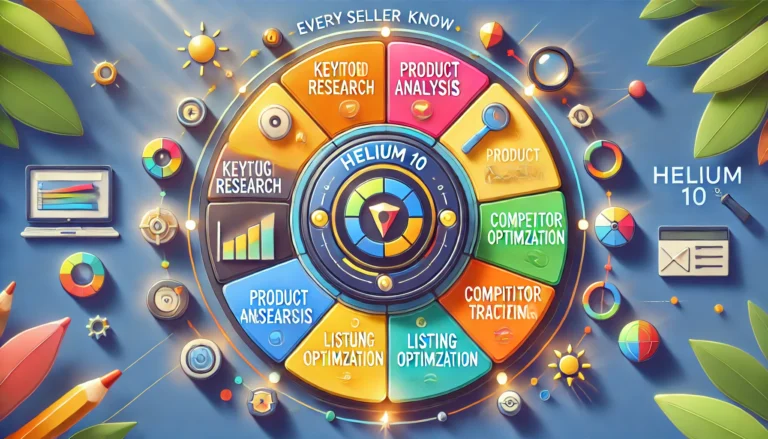Integrating Helium 10 with Your eCommerce Business Strategy
Did you know that integrating Helium 10 with your e-commerce business strategy can boost your sales by up to 76%?
This powerful woo-commerce tool offers a range of features to streamline your operations and maximise profits. From keyword research to product listings, Helium 10 has got you covered with commerce tools and seller power.
With over 2 million users worldwide, it’s clear that this platform is a game-changer in the e-commerce industry. Stay ahead of the competition and take your business to new heights with Helium 10.
Key Takeaways
- Utilise Helium 10 API: Integrate Helium 10 into your e-commerce strategy to enhance product research, keyword tracking, and listing optimisation.
- Follow Best Practices: When setting up the API, ensure proper configuration and data management to maximise its benefits for your business.
- Avoid Common Mistakes: Stay vigilant against errors like incorrect data input or misconfigurations that can hinder the seamless integration of Helium 10.
- Troubleshooting Tips: Be prepared to tackle challenges by understanding common issues and implementing practical solutions for a smooth operation.
- Optimise with Advanced Techniques: Explore Helium 10’s advanced features for in-depth market analysis, competitor insights, and strategic decision-making.
- Learn from Success Stories: Draw inspiration from real-world cases where Helium 10 integration has led to significant business growth and improved strategies.
Understanding Helium 10 API
Accessing Data
The Helium 10 API enhances e-commerce operations by providing access to various tools and data. This integration allows businesses to delve into in-depth helium data analytics, enabling them to make informed decisions based on accurate insights.
The Helium 10 API allows e-commerce businesses to streamline their entire helium process. The API offers instructions on extracting valuable data, helping companies implement best practices for optimal performance. Through this integration, businesses can efficiently manage their operations and boost productivity.
Facilitating Decision-Making
One key benefit of integrating Helium 10 with your e-commerce strategy is the ease of accessing critical data. The API provides detailed insights into market trends, competitor analysis, and product performance. This information empowers businesses to make strategic decisions based on real-time data.
With the Helium 10 API, e-commerce entrepreneurs can gain a competitive edge by leveraging automation tools. These tools automate repetitive tasks such as keyword research, product tracking, and listing optimisation. By automating these processes, businesses can save time and focus on core activities that drive growth.
Streamlining E-commerce Tasks
Automation is a game-changer in the e-commerce landscape, and the Helium 10 API enables businesses to automate various aspects of their operations. From inventory management to pricing strategies, automation simplifies complex tasks and ensures efficiency across the board. This streamlined approach enhances productivity and profitability.
When I first integrated Helium 10 with my e-commerce store, the automation features significantly reduced manual workloads. By automating keyword research and product tracking, I could allocate more time to customer engagement and marketing strategies, increasing sales and customer satisfaction.
Key Features and Benefits
Importance of Product and Keyword Research
Product and keyword research are essential for understanding customer needs and preferences. Businesses can tailor their offerings by analysing popular products and trending keywords to meet market demands. This research helps identify high-demand products and relevant keywords to boost sales.
Competitor analysis plays a crucial role in determining market positioning. By studying competitors ‘ strategies, businesses can gain valuable insights into pricing, marketing tactics, and product assortment. This information enables companies to differentiate themselves, identify gaps in the market, and develop unique selling propositions.
Listing optimisation is critical to enhancing visibility and driving conversions on e-commerce platforms. By optimising product titles, descriptions, and images with relevant keywords, businesses can improve search rankings and attract more potential customers. Optimised listings also help provide clear and compelling information to shoppers, increasing the likelihood of purchase decisions.
Value of Listing Optimisation
- Pros:
- Improved search visibility
- Higher conversion rates
- Enhanced customer engagement
- Cons:
- Time-consuming process
- Requires ongoing monitoring and updates
Effective listing optimisation involves creating detailed and informative product listings that resonate with target audiences. Businesses can stand out in crowded online marketplaces by highlighting unique selling points, addressing customer pain points, and using compelling visuals.
In my experience, conducting thorough product research helped me identify niche opportunities and develop tailored offerings that resonated with my target audience. Analysing keywords and competitor strategies gave me valuable insights that guided my marketing decisions and improved my online visibility.
Significance of Competitor Analysis
Competitor analysis offers information that can shape business strategies and decision-making processes. By evaluating competitors’ strengths and weaknesses, businesses can identify areas for improvement, refine their value propositions, and stay ahead of industry trends. This analysis also provides benchmarks for performance evaluation and goal setting.
Setting Up the API
Creating a Helium 10 Account
To begin integrating Helium 10 into your e-commerce strategy, the first step is to create a Helium 10 account. Visit the Helium 10 website and sign up for an account using your email address and a secure password. Once your account is set up, you can access the various tools and features that Helium 10 offers to enhance your e-commerce business.
Obtaining Your API Key
After creating your Helium 10 account, the next crucial step is to obtain your API key. The API key serves as a unique identifier that allows you to connect your e-commerce platform with Helium 10 seamlessly. To obtain your API key, navigate to the API section within your Helium 10 account settings. Follow the instructions provided in the API documentation to generate and retrieve your unique API key.
Tailoring API Settings
Once you have obtained your API key, tailoring your API settings to align with your business objectives is essential. Customising your API settings enables you to optimise the integration between Helium 10 and your e-commerce platform. You can configure settings such as data access permissions, frequency of data updates, and integration preferences to ensure seamless and efficient data exchange between platforms.
Establishing Secure Authentication Measures
When integrating Helium 10 with your e-commerce business strategy, it is paramount to establish secure authentication measures to protect the integrity of your data.
Implementing robust authentication protocols helps prevent unauthorised access and safeguard sensitive information. Utilise encryption technologies, multi-factor authentication, and other security measures to ensure that only authorised API users can securely access and interact with your data.
I recently integrated Helium 10 with my E-commerce platform. Customising the API settings according to my business needs improved data accuracy and efficiency. By tailoring the settings, I could streamline data synchronisation processes and enhance overall operational performance.
Best Practises for Integration
Regular Reviewing
API documentation should be regularly reviewed to stay updated on any new features or changes. This ensures that you are leveraging the latest tools and functionalities provided by Helium 10. By staying informed, you can adapt your integration strategy accordingly and take advantage of any improvements that could benefit your business.
It is essential to allocate time for frequent checks on the API documentation. This practice allows you to avoid any modifications or updates impacting your integration. For example, I make it a habit to set aside time each week to review the documentation and note any fundamental changes that could enhance my integration process.
Thorough Testing
Thorough integration testing is crucial to guarantee their functionality and reliability. Before fully implementing any changes or updates, conducting comprehensive tests to identify potential issues or bugs is advisable. This step helps ensure a smooth transition and minimises disruptions to your e-commerce operations.
When testing integrations, focus on simulating real-world scenarios to assess how well the system performs under different conditions. For instance, I often create test cases based on past challenges faced by my business to ensure that the integration can handle similar situations effectively. This proactive approach has helped me anticipate and address potential issues before they escalate.
Monitoring API Usage
Monitoring API usage is critical to optimising performance and resource allocation within your e-commerce business. By tracking how your APIs are being utilised, you can gain valuable insights into usage patterns and identify areas for improvement or optimisation. This data-driven approach enables you to make informed decisions about resource allocation and streamline your operations effectively.
Setting up automated monitoring tools can significantly simplify tracking API usage. These tools provide real-time data on how APIs are accessed and help identify anomalies or inefficiencies. Regularly analysing this data enables me to make informed decisions about scaling resources or adjusting integration settings for optimal performance.
Common Mistakes to Avoid
Exceeding API Rate Limits
One common mistake to avoid when integrating Helium 10 with your e-commerce business strategy is exceeding API rate limits. This can disrupt service, impacting your integration’s functionality and performance. To prevent this, monitoring and managing your API usage carefully is crucial.
Implementing error handling is essential to mitigate unexpected issues during the integration process. By setting up proper error handling mechanisms, you can ensure smoother operations and quicker resolution of any technical glitches.
Ignoring Valuable Data Insights
Another mistake to avoid is ignoring valuable data insights provided by Helium 10. These insights can offer crucial information that could significantly influence your business strategy, helping you make informed decisions and stay ahead of the competition.
- Properly managing API rate limits
- Implementing robust error-handling mechanisms
- Leveraging valuable data insights for informed decision-making
When I first integrated Helium 10 with my e-commerce business, I overlooked monitoring API rate limits. This led to a temporary disruption in service, affecting customer experience. Learning from this mistake, I now closely monitor and manage API usage to avoid such issues in the future.
In another instance, I encountered unexpected errors during the integration process due to inadequate error handling. This resulted in delays in resolving technical issues and impacted operational efficiency. Since then, I have prioritised implementing comprehensive error-handling protocols to address any unforeseen challenges promptly.
Troubleshooting Challenges
Issues
Facing issues during the integration process is standard. Referring to the API documentation for guidance on resolving these challenges effectively is essential.
Reaching out for professional help can provide valuable assistance when encountering complex integration problems. Experts can offer tailored solutions to address specific issues.
Documenting your challenges is crucial for gaining insights and improving future integration efforts. Recording the troubleshooting process can streamline future processes.
Solutions
Finding practical solutions to integration challenges requires a systematic approach. Utilise the resources provided by Helium 10 to troubleshoot and resolve issues efficiently.
Consulting the documentation available on the platform can offer step-by-step guidance on overcoming common integration hurdles. Following these guidelines can lead to successful outcomes.
When seeking support from Helium 10, be prepared to provide detailed information about the issues encountered. Clear communication can expedite the resolution process.
Marketplace Understanding
Understanding the marketplace dynamics where your e-commerce business operates is essential for seamless integration. Tailoring your strategies to fit the marketplace requirements can enhance overall performance.
Advanced Techniques for Optimisation
Batching API Requests
Batching API requests is a technique that involves grouping multiple requests into a single call, enhancing efficiency and reducing latency. The system can quickly process data and streamline operations by sending fewer requests. This approach is particularly beneficial when dealing with large volumes of data or conducting frequent interactions with external systems. Implementing batching API requests can significantly improve the overall performance of an eCommerce platform.
When I first started implementing batching API requests in our eCommerce business, I noticed a remarkable decrease in response times and increased operational efficiency. The ability to handle multiple tasks simultaneously allowed us to scale our operations effectively and cater to a growing customer base. It was a game-changer in optimising our backend processes and enhancing the overall user experience.
Custom Dashboards for Data Visualisation
Custom dashboards offer advanced data capabilities by providing tailored visual representations of key metrics and insights. These dashboards can be customised to display KPIs, trends, and performance indicators relevant to the eCommerce business. By visualising data clearly and intuitively, decision-makers can quickly identify patterns, anomalies, and opportunities for improvement. Custom dashboards empower users to make informed decisions based on real-time data analysis.
In my experience, leveraging custom dashboards for data visualisation has revolutionised tracking and monitoring key performance indicators in our eCommerce operations. Creating personalised views that align with our business objectives has enabled us to gain deeper insights into customer behaviour, sales trends, and inventory management. Custom dashboards have become indispensable tools for strategic decision-making and achieving business goals efficiently.
Integrating Machine Learning Algorithms
Integrating machine learning algorithms into eCommerce operations can unlock powerful predictive analytics capabilities. These algorithms analyse historical data patterns to forecast future trends, customer behaviour, and market dynamics.
By harnessing the power of machine learning, businesses can automate processes, personalise customer experiences, and optimise pricing strategies. Machine learning algorithms enable eCommerce businesses to stay ahead of the competition by making data-driven decisions that drive growth and profitability.
When I integrated machine learning algorithms into our eCommerce strategy, I was amazed by the accuracy and precision of the predictive analytics models generated. These models provided valuable insights into customer preferences, product demand fluctuations, and seasonal trends.
By leveraging machine learning algorithms, we could anticipate market changes proactively and adjust our strategies accordingly, leading to increased sales and customer satisfaction.
Real-World Success Stories
Business Integration
Numerous businesses have successfully integrated Helium 10 with their e-commerce operations. For instance, a small online retailer saw a significant increase in sales after implementing the API. Another example is a medium-sized company that expanded to different marketplaces using Helium 10’s tools.
One key strategy these businesses employed was conducting in-depth research on their target audience. By leveraging Helium 10’s data analysis capabilities, they gained valuable insights into customer preferences and behaviours, which enabled them to tailor their online sales strategies for maximum impact.
Measurable Growth
By utilising Helium 10, these businesses could make informed decisions directly impacting their performance. For example, one company used the platform to identify high-demand products and adjust its inventory accordingly. As a result, it experienced a substantial increase in revenue within a short period.
Another crucial aspect of their success was the ability to reach a wider audience. Helium 10 helped them optimise their listings for different marketplaces, increasing visibility and driving more traffic to their online stores. This led to a boost in conversions and overall reach.
Inspiring Strategies
The success stories of these businesses inspire others looking to enhance their e-commerce strategies. One common approach among successful users is continuously monitoring market trends and competitor activities using Helium 10’s tools. This proactive stance allows them to stay ahead of the curve and adapt quickly to changes in the world of commerce.
Moreover, these professionals emphasised the importance of post-analysis. They regularly reviewed their online sales data and performance metrics to identify areas for improvement and refine their strategies. This commitment to ongoing research and analysis significantly impacted their growth and success.
Personal Insights
I have witnessed how integrating Helium 10 can transform an e-commerce business’s fortunes. By following the steps outlined by successful users, I was able to streamline my operations and make more informed decisions based on real-time data. This experience highlighted the immense value Helium 10 brings to online sellers seeking to elevate their performance in the competitive commerce world.
Enhancing Business Strategy
Data-Driven Insights
Using Helium 10 provides valuable data-driven insights that can refine marketing strategies effectively. The tool comprehensively analyses keyword trends, competitor performance, and market demand.
Aligning product offerings with the latest market trends identified through the API is crucial for staying competitive in the ever-evolving e-commerce landscape. By leveraging Helium 10’s data, businesses can accurately tailor their products to meet customer needs and preferences.
Continuous Evaluation and Adaptation
Continuous evaluation and adaptation of business strategies based on API data are essential to thriving in a competitive marketplace. Helium 10 allows businesses to monitor changes in consumer behaviour, adjust pricing strategies, and identify new growth opportunities.
- Pros:
- Enhanced marketing strategies
- Tailored product offerings
- Real-time market insights
- Cons:
- The learning curve for new users
- Requires time for analysis and implementation
Incorporating Helium 10 into an e-commerce business strategy can boost growth and elevate online marketplace competitiveness. Businesses can optimise their commerce operations by effectively utilising the tool’s features, driving sales and maximising profits. Incorporating Helium 10 into an e-commerce business strategy can boost growth and elevate online marketplace competitiveness. Businesses can optimise their commerce operations by effectively utilising the tool’s features, driving sales and maximising profits. By leveraging keyword research and competitor analysis powered by Helium 10, sellers can position their products more effectively in crowded marketplaces. “Maximizing Your Product Launch with Helium 10 Strategies” ensures that businesses not only gain valuable insights but also execute launches that capture customer attention and accelerate early sales momentum. This approach empowers entrepreneurs to make data-driven decisions, ultimately enhancing brand visibility and customer engagement.
Summary
In integrating Helium 10 with your e-commerce strategy, remember the importance of understanding its API, leveraging key features, and implementing best practices.
Setting up the API correctly while avoiding common mistakes and being prepared for troubleshooting challenges is essential for success.
By exploring advanced techniques and real-world success stories, you can enhance your business strategy significantly.
Keep pushing boundaries, stay updated on industry trends, and continuously optimise your approach for sustainable growth and profitability.
The journey to integrating Helium 10 is ongoing – embrace it proactively and drive your e-commerce business towards greater heights.
Frequently Asked Questions
How can integrating Helium 10 with my ecommerce business strategy benefit me?
Integrating Helium 10 provides powerful tools for product research, keyword tracking, and listing optimisation, boosting your sales and visibility on online marketplaces. It streamlines processes, enhances decision-making, and increases profitability.
Do you need help to set up the Helium 10 API for integration?
Setting up the Helium 10 API is straightforward, with clear documentation and user-friendly interfaces. By following the step-by-step guides provided by Helium 10, you can quickly configure the API to integrate with your e-commerce platform seamlessly.
What are some best practices to successfully integrate Helium 10 with my business strategy?
To maximise the benefits of Helium 10 integration, regularly update your data, leverage automation features, conduct thorough keyword research, and analyse competitor insights. Implementing a structured approach and staying informed about new features is critical.
What are common mistakes to avoid when integrating Helium 10 into my e-commerce operations?
Common mistakes include:
- Neglecting regular updates.
- Underutilising keyword research tools.
- Overlooking competitor analysis.
- Failing to customise settings for optimal performance.
By avoiding these pitfalls and staying proactive, you can enhance your integration experience.
How can I address troubleshooting challenges that may arise during Helium 10 integration?
When troubleshooting challenges, refer to Helium 10’s support resources, such as FAQs, forums, and customer service. Double-check configurations, review error messages carefully and seek assistance from experts or community members for timely solutions.







